MMC3
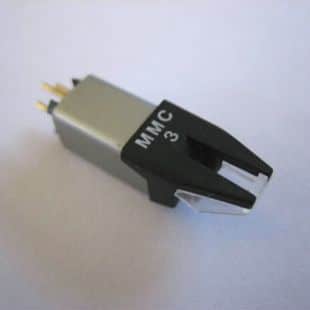
This cartridge was in many ways the replacement for the MMC20EN as it had a tapered cantilever and naked elliptical stylus.
It was fitted as standard to the Beogram 6002.

This cartridge was in many ways the replacement for the MMC20EN as it had a tapered cantilever and naked elliptical stylus.
It was fitted as standard to the Beogram 6002.
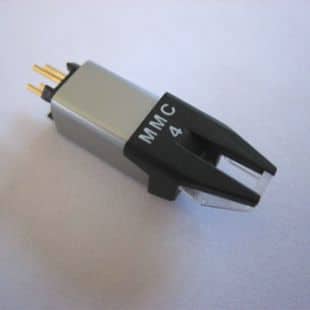
This could be regarded as the standard cartridge in the range and was fitted to many decks as standard.
In many ways a replacement for the MMC20E, it offered good performance at a most reasonable price
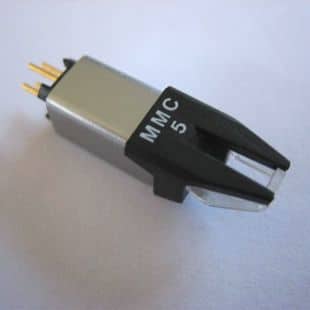
The most basic of the range, this cartridge was available to be specified for those decks not fitted with a cartridge as standard such as the Beogram RX.
It could be differentiated by its cantilever which was a straight non tapered aluminium tube.
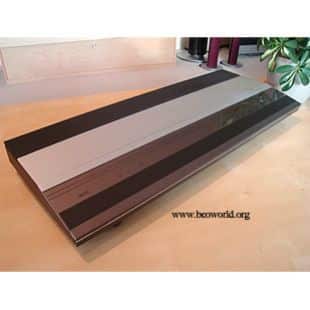
Beosystem 3300: a 2 x 40 watts RMS amplifier, an FM, long and medium wave radio, and a stereo record deck – was all combined into a single unit called Beomaster 3300. The record deck was fitted with the Bang & Olufsen MMC 20E cartridge. Two Beovox Uni-Phase S45 loudspeakers completed this value-for-money system.
Beosystem 3300: blending science and art
Bang & Olufsen designs are always refreshingly different – a pleasure to look at as well as to hear. Which could be why the company has earned itself over the years coveted places in the Museum of Modern Art in New York.
Beosystem 3300 was the latest addition to a collection which fascinated people from all over the world. You could hang it on the wall among your other works of art; or place it where you like – those sleek, modern shapes would always look good.
But Beosystem 3300 had a great deal more to offer than an ultra-modern appearance. With records, tapes, radio and compact discs it was a top quality music system that really knew how to perform, according to the 1988 catalogue.
Beomaster 3300 Type 2951
This receiver was the heart of the system, connected by Datalink to the other equipment and passing on the commands you gave via remote control, or by a light touch directly on the panel.
You could preset up to five radio stations. The amplifier had a power output of 2 x 30 watts and a power handling system which prevented overloading and distortion. Beomaster 3300 was part of Beosystem 3300 although it could be used as a stand-alone item.
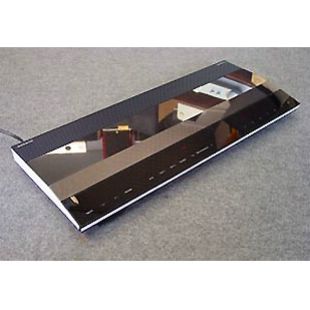
The Beomaster 4500 radio/amplifier received both FM and AM radio and was your communication link to the other sound sources in the system. Its operation was simplicity itself with an illuminated menu presenting all the options available. 20 radio stations could be pre-set providing you with instant access together with automatic fine tuning.
The 2 x 55 watt/8 ohm amplifier had a newly-developed, well-balanced interplay with the power supply which gave the output extra strength. The power reserve encompassed the entire frequency range and gave stable sound quality no matter what the volume. Beomaster 4500 also had automatic power handling control that prevented overloading, no matter how many loudspeakers were connected, as well as a special loudspeaker socket which ensured optimal utilisation of BeoLab active loudspeakers.
Beomaster 4500 could be used as part of the Beosystem 4500 hi-fi system and could be controlled via a Beolink 1000 remote control terminal. Later models of Beomaster 4500 could be controlled by the two-way Beolink 5000 and had the extra benefit of programmable timer functions (note that only Beomaster 4500 models with a software version of 2.1 and higher were able to handle two-way communication as well as the timer function.)
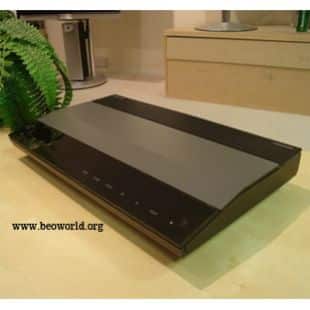
The sound reproduction achieved by Bang & Olufsen’s CD 3500 CD player was truly outstanding. It played both 12cm and 8cm compact discs and had an ingenious ‘step’ function which allowed you to go straight to a chose track selected from anywhere on the disc. The CD player was one of the most technologically-advanced pieces of hi-fi on the market at the time and yet was one of the easiest to operate. The explicit display always indicated what the CD player was doing all the time – for example, which track was being played, and how many tracks there were on the played compact disc.
Beogram CD 3500 could be used as part of the Beosystem 3500 hi-fi system.
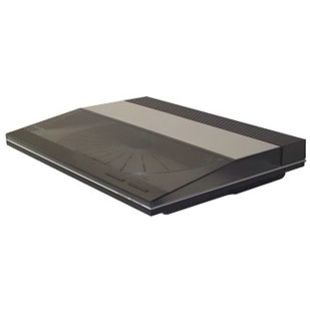
It’s better both for your records and for sound quality to play a record the way the master was made – in a straight line from the edge to the centre. This tangential arm record player did just that, giving a far more precise reading of the signals in the groove. The MMC4 cartridge made a vital contribution too; it was feather-weight, with a stylus pressure of only 1,2 grams, giving outstanding sound quality but minimising wear and tear on your records.
There’s more protection too – invaluable for all-night parties. The electronically controlled tangential arm was suspended so that it isolated mechanical vibrations from the cartridge. The suspension chassis was also thoroughly engineered to neutralise vibrations. So keep on dancing – the record player can take it! Beogram 3300 was part of Beosystem 3300 although may be used as a stand-alone item.
One of many tangential decks all utilising the same basic design, the 3300 was noticeable mainly for its grey finish and slightly lurid graphics. Very much a child of the 80s, it was replaced by the 3500 and 4500.
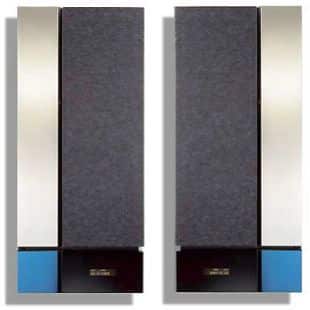
Bang & Olufsen’s BeoLab and Beovox 5000 / 3000 speakers had both the voice and the looks for a leading, acoustic role. And because of their looks, they were known as Bang & Olufsen’s range of panel loudspeakers. Panel loudspeakers were one of the most exciting and interesting examples of how Bang & Olufsen united advanced technology and stunning design to achieve totally new effects.
They may not have looked like high-specification loudspeakers – more like works of art – but their sound immediately gave them away. Even at full volume, they kept the total sound picture in perfect balance.
Design as a work of art
The elegant, flat panel loudspeakers were created to hang on the wall. And with their calm surfaces of blue or grey fabric coupled with polished steel, they could be taken for works of art. But the design was only partly for visual effect. The form of the panel speakers was founded on an advanced, acoustic principle that uses the wall as an active part of the sound reproduction process – without causing the wall itself to vibrate.
Optional display and amplifier
The panel loudspeakers were available in two sizes – each with or without amplifier and a display showing which source was playing and at what volume. Also it told you which track number on a CD or tape you were listening to. With display and amplifier the loudspeakers were called BeoLab. Without, they were called Beovox. The option depended upon which Bang & Olufsen sound system was connected. BeoLab speakers were designed to match Beosystem 6500, 4500, 3500 and Beocenter 9500 and 8500.
Why build amplifiers into the loudspeakers instead of keeping them separate?
Because you can reduce the size of the cabinet volume to one-third of the size of a conventional loudspeaker with the same sound capacity. The principle is called Active Loudspeakers, and what you get is a compact loudspeaker that can play at high volume without distortion or damage to its drive units. Furthermore, when amplifier, treble and bass units are paired for the same task, they can be tailored to compensate for each other’s shortcomings. What you hear is music that sounds exactly like the instrument it originally came from.
Mounting Options
Wall mounting brackets were supplied with this model. No other mounting solution wall offered.
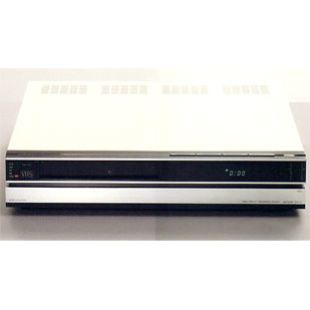
With Beocord VHS 91.2 Bang & Olufsen created a stereo video tape recorder which, in 1987, was close to studio equipment in terms of sound and picture quality. And when it came to design, operation and uses it was a natural, integrated part of home entertainment and communication.
Beocord VHS91.2 could record up to four hours of video or eight hours of stereo hi-fi sound on just the one four-hour tape. And it could of course be remote-controlled regardless of which Bang & Olufsen TV and music system you put it to work with.
The many picture functions included such things as distortion-free single frame pictures, play back just one picture at a time, ‘flickerless’ breaks between recordings and automatic picture search with the help of the tape counter. And Beocord VHS91.2 could also be programmed to record daily or weekly for an unlimited period of time.
With a completely new recording technique and one built-in stereo decoder, Beocord VHS 91.2 provided unlimited possibilities for combining TV, video and music systems, such as recording stereo simulcasts.
In terms of design, colours and uses, Beocord VHS 91.2 was created to harmonise with Beovision MX2000. And the same remote control Terminal could be used to control both units.
A mildly updated VHS82 designed to work with the new range of MX televisions.